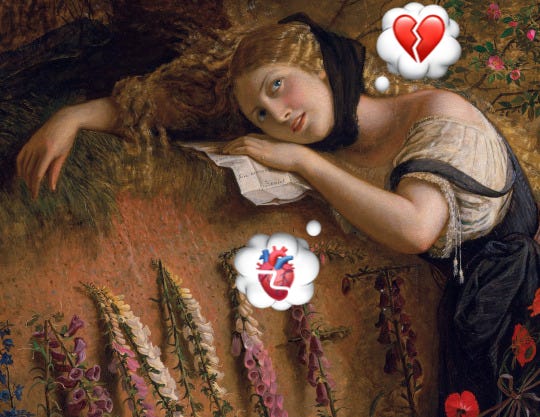The Wit's Guide to Heartbreak
Or, cardiac crack
Heartbreak is too good a metaphor, it turns out. Takotsubo cardiomyopathy, aka broken heart syndrome, was identified by Japanese researchers in 1990. It afflicts otherwise healthy people when a surge of stress hormones floods the heart, and it’s responsible for a non-negligible percentage of sudden-cardiac hospital admissions.
This is the sort of thing you learn when you skip the heartbreak poetics and get right to the data. Florence Williams did exactly that to process her dissolving marriage. “If this was such a common and devastating experience,” the science journalist writes in her new book Heartbreak: A Personal and Scientific Journey, “why wasn’t there a validated protocol for recovery beyond weep-dancing while belting out Gloria Gaynor?”
“There’s no such thing as advice to the lovelorn. If they took advice, they wouldn’t be lovelorn.”
— Fran Lebowitz
It spoils nothing to reveal that the myriad steps Williams takes — everything from taking psychedelic drugs to visiting the Museum of Broken Relationships in Zagreb, Croatia — “probably sped up my heartbreak convalescence between 25 and 50 percent.” She proves that agile mind can ease a broken heart, and she uncovers such quips as:
“The tragedies of life are largely arterial.”
— William Osler
The heartbroken are not usually inclined to deliver epigrams about their plight. They are, however, prone to metaphor. Consider Elvis Presley and his chosen accommodations down at the end of lonely street.
We know from the song that the bellhop can’t stop crying and the desk clerk’s dressed in black, but only in John Brehm’s 1996 poem “Postcard from the Heartbreak Hotel” do we get the granular details. “Wish you were here instead of me,” he begins, and offers such tidbits as
“It has a fantastic view
of the vast unconscious ocean,
into which a few of the guests
will no doubt fling themselves
before their stay is through.”
Ray Charles’ “I’m Going Down To The River and Drown Myself” is a great song but certainly not proof that the broken-hearted just need to sing the blues. Learning from sorrow is the subject of the apocryphal book The Joyful Guide to Lachrymology, meaning the study of tears. It’s said to be written in 1949 by Ronald P. Vincent after his wife’s tragic dismemberment by a snowplow, but the non-existent guide is actually a long-running inside joke told by the band Tool as a way of mocking Scientologists.
“On the outskirts of every agony sits some observant fellow who points.”
— Virginia Woolf
Nora Ephron famously turned her heartbreak into Heartburn, driven by the belief that “if I tell the story, I can make you laugh, and I would rather have you laugh at me than feel sorry for me.” It makes good sense to reassert narrative control, as Florence Williams does with honesty and empathy.
Finally, the coldest shard of cold comfort from a wallowing wit: It’s better to be heartbroken than a heartbreaker.
Once, when I was young and true,
Someone left me sad —
Broke my brittle heart in two
And that is very bad.Love is for unlucky folk,
Love is but a curse.
Once there was a heart I broke;
And that, I think, is worse.
— Dorothy Parker
Quote Vote
“What’s he building in there?
We have a right to know!”
— Tom Waits
“Life is the art of drawing sufficient conclusions from insufficient premises.”
— Samuel Butler
My goal with this series of Wit’s Guides is to create a womb-to-tomb survey of existence, building an instruction manual from only the clever bits. Follow along! Fill in the blanks! Life is short, art is long, or maybe vice versa. It really depends on the day.
Speaking of…
Nora Ephron
Dorothy Parker
GWQ No. 167 is a sturdy rope bridge across the vale of tears. Use the superabsorbent pages of Elements of Wit: Mastering The Art of Being Interesting to dry those eyes. Weep-dance with the one that brung ya and don’t break the ❤️ below.



